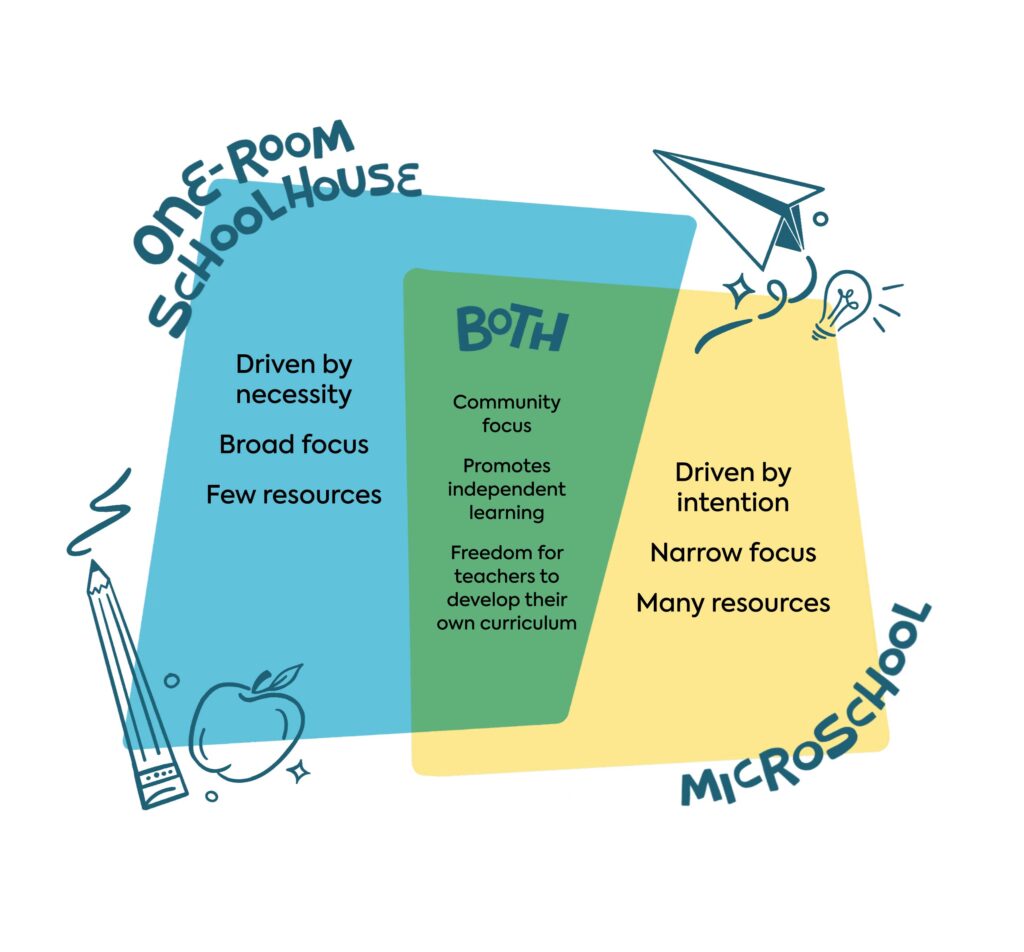Table of Contents
Microschools: A New Idea Inspired by America’s Past
Just for a moment, let’s take a trip down memory lane and reflect on your learning experiences – from early childhood to the present. Think about all the valuable skills, concepts, and ideas you have absorbed over the years. Did you learn by memorization, hands-on experiences, or a trial-and-error approach? Did you ever have to fail multiple times before achieving near perfection?
Now, imagine a child in your life who is of school age. What kind of learning environment would you want for them? A traditional classroom with rows of desks and a chalkboard? Or something more personalized, catered to their unique academic and social needs? A place where curiosity is encouraged, and discovery is celebrated? A place where every student is positioned to thrive?
Alternative educational paths have risen during the pandemic, emphasizing a more personalized approach. You may have heard of the surge in homeschooling, the emergence of learning pods, and the latest evolution in education – Microschools.
Microschools, though a recent addition to the education landscape, embody the spirit of America’s past one-room schoolhouses. Nearly a century ago, one-room schoolhouses were prevalent, especially in rural America. In 1930, 65% of the nation’s school buildings were one-room schoolhouses. These historical, educational settings share similarities with today’s Microschools, particularly in their approach to learning. Microschools embody the ethos of a one-room schoolhouse but with more intention and focus. Let’s take a look at some similarities and differences below.

Today, Microschools are defined as deliberately small learning communities that offer a personalized education experience to students. These schools focus on meeting the unique needs of each student and blend traditional teaching methods with new, innovative approaches. If you’re looking for an intimate and tailored learning environment for your child, Microschools may be what you’re looking for, whether it’s joining an existing one or starting your own.
Why Microschools?
As the world continues to evolve at a rapid pace, education is also transforming to cater to diverse needs. While traditional classrooms have been effective for many years, they do not always meet the unique requirements of every student.
This is where Microschools come in, offering a promising solution for personalized learning experiences. These small and intimate learning communities blend traditional teaching methods with innovative approaches to education. Microschools provide customized curricula that cater to individual student needs and interests. The students receive personalized attention and support from their teachers or learning coaches, who are well-equipped to adapt to their specific needs. This allows students to learn at their own pace, and teachers can provide guidance and support for them to reach their full potential.
Microschools offer students a strong sense of community, where they can form meaningful connections with their peers and teachers. With a collaborative and supportive learning environment, students can feel more engaged and motivated to learn. As a result, they can develop critical thinking skills, creativity, and a lifelong love for learning. Microschools are an exciting and innovative way to revolutionize education, providing a unique and personalized approach that can benefit students in a variety of ways.
Why Microschools are Gaining Popularity
- Personalized Learning Paths: In Microschools, due to their size, focus, flexibility, and other factors, it becomes possible to personalize education paths for each student. This customization makes learning more relevant and engaging.
- Community, Connection, and Collaboration: The small scale of Microschools fosters strong relationships among students, teachers, and parents. Microschools encourage students to work together and learn from each other, which helps them develop vital skills such as teamwork, conflict resolution, and relationship building.
- Holistic Approach: Microschools take a holistic approach to education, focusing on the whole child, not just their academic skills. They help children develop emotionally and socially, preparing them for life’s challenges.
- Flexibility and Innovation: Microschools adapt quickly to educational trends and technology, ensuring they meet students’ changing needs.
- Embracing Diversity: Microschools provide inclusive spaces celebrating diverse learning paths, allowing every student to thrive.
The Tangible Benefits of a Microschool Education
- Enhanced Student Experience: Small class sizes in Microschools mean individualized attention for each student, and student-led learning means children have a say in their learning journey. These approaches foster academic growth and a passion for lifelong learning.
- Social-Emotional Learning: Many Microschools prioritize social-emotional learning, which can be integrated into the curriculum. Empathy, resilience, and effective communication are woven into daily lessons, enhancing students’ overall educational experience.
- Empowering Parents: Parents in Microschools play a significant role in shaping their child’s education to align with individual needs and family values.
- Rewarding Opportunities for Educators: Teachers in Microschools enjoy the freedom to innovate and personalize their teaching, leading to increased job satisfaction and professional growth.
- Community Engagement and Economic Benefits: Microschools often serve as community hubs, enhancing local engagement and partnering with businesses to boost the economy.
Microschool Flavors: Tailoring Education to Every Need
Every student has unique interests, strengths, and learning needs. Microschools offer a flexible learning environment that can adapt to the specific needs of each student. Here are some examples of Microschools to show you how diverse they can be:
Coworking-style Microschool: Imagine a space where students can choose what they want to learn, just like adults pick their projects in a co-working space. This setting encourages independence, self-direction, and collaborative learning.
Nature-based Microschool: In this type of Microschool, the classroom extends into the great outdoors. Lessons are intertwined with nature, offering hands-on experiences in environmental science, biology, and geography. This setting fosters a deep connection with the natural world and promotes ecological awareness. Check out our guide to starting a nature school here.
Arts-focused Microschool: In this Microschool, creativity takes center stage. The curriculum involves artistic expression, visual arts, music, dance, and drama. Students are encouraged to explore their creative talents, fostering creativity and emotional expression.
Science and innovation hub: This type of Microschool focuses on science, technology, engineering, and mathematics (STEM). It’s equipped with spaces where students engage in experiments, coding, and robotics, preparing them for a future in innovation and technology.
Microschool for gifted learners: For students who are not adequately challenged in a traditional school, a Microschool for gifted learners can help them reach their full potential. These Microschools provide rigorous academics and encourage students to pursue independent learning and advanced studies.
Microschool for neurodiverse learners: At this kind of school, the lessons and environment are tailored to neurodiverse students. The one-on-one attention and flexibility help neurodiverse learners thrive, while the smaller classroom setting is easier to navigate than a large traditional school.
Secular and faith-based options: Families have diverse needs and values. That’s why Microschools can be secular, focusing on a broad, non-religious educational experience, or faith-based, incorporating religious teachings and values into the curriculum. This flexibility allows families to choose a school that aligns with their beliefs and values.
Can You Be a Microschool Founder?
Microschool founders are a diverse group of people. Everyone has their own specific motivations for starting a school, but many share similar passions. Have you ever thought about founding your own Microschool?
Are you a classroom teacher or administrator? Teachers from both public and private schools are increasingly turning to Microschooling due to the opportunity it provides for career growth. These educators possess a unique skill set, with a deep understanding of pedagogical techniques and educational systems. This expertise allows them to creatively adapt to the intimate and flexible environment of a Microschool. In our most recent KaiPod Catalyst cohort, 74% are former traditional classroom teachers, and 26% are former school administrators.
Are you a homeschooling parent? Parents who homeschool their children have experience creating customized educational plans for their families. As Microschool leaders, they can expand this skillset to serve more families in their community.
Are you a community leader? Community leaders see Microschools as an effective means to create a positive social impact. Their deep understanding of the community’s needs and dynamics allows them to establish Microschools that cater to the specific educational gaps, thus resonating with local families.
Are you an education entrepreneur? Entrepreneurs who have successfully run other businesses are increasingly looking for ways to support education transformation in their communities. Their entrepreneurial spirit, business acumen, and passion for educational reform make them ideal for exploring and implementing new educational models.
Are you passionate about personalized learning? With a Microschool’s smaller class sizes, teachers can provide individual attention to each student, which helps create a safe and supportive space where students feel comfortable enough to ask questions. This personalized approach allows teachers to meet each child’s needs.
Are you passionate about creating a more equitable education system? With community support, Microschools can break down some of the systemic inequalities students might face in traditional schools.
Are you looking for more freedom and opportunity to innovate in your role? Many educators want the freedom to craft customized learning experiences and implement their knowledge in more individualized settings.
If you answered “Yes” to any of these questions, you might be a great fit for a Microschool founder!
Starting a Microschool: 8 Building Blocks for Success
To build a successful Microschool, it is crucial to focus on eight foundational elements that lay the groundwork for your educational institution. Kaipod is here to help with resources at every step of the way.
- Define Your Vision: Establishing a clear vision for your Microschool is one of the most crucial first steps. Take a look at our vision building kit to get started.
- Choose a Curriculum: Creating a curriculum from scratch can be a lot of work and requires specialized knowledge, which can be difficult for new school founders. Luckily, many pre-made curricula are available that can be a great fit for various educational needs.
- Shape the Student Experience: It is essential to establish an engaging environment to ensure the success of your Microschool. This entails designing the learning space’s layout, creating a daily schedule, and fostering connections and trust between you, the students, and their parents.
- Ensure Legal Compliance: Ensuring legal compliance is critical to the success of your Microschool. You must delve into the legal aspects of running a school, from program licensure to safety standards and staff qualifications.
- Plan for Finances: When it comes to running a Microschool, planning for financial sustainability is an essential component of achieving long-term success. Our financial and fundraising guide can guide you along the way.
- Choose the Right Location: Regardless of where your Microschool is located, it must support the students’ educational goals and be accessible to the community. Take a look at some common options and considerations here.
- Develop Marketing Strategies: When promoting your Microschool and attracting students, developing a comprehensive marketing plan that considers your target audience is important. Our guide to promoting your Microschool can help you get started.
- Manage the Day-to-Day: Running a successful Microschool requires a careful and methodical approach to managing its day-to-day operations, from hiring and training teachers to creating a schedule to allocating resources.
Embracing the Entrepreneurial Journey
Starting a Microschool can be a life-changing journey for many aspiring educators and entrepreneurs. However, it is no easy feat, especially for those new to the world of entrepreneurship. Here are some key obstacles you might face, along with strategies to address them:
Building a Supportive Community: One of the most critical factors in a Microschool’s success is its surrounding community’s strength. Actively engage with your local area through events and workshops, and utilize social media to extend your reach and foster connections.
Navigating Entrepreneurial Solitude and Imposter Syndrome: Stepping into entrepreneurship can often lead to feelings of isolation and doubt. It’s common to experience imposter syndrome, where you might question your capabilities as an educator and entrepreneur. To combat this, cultivate a network of mentors and peers who understand your journey. Celebrate your achievements, no matter how small, to build confidence in your role.
Embracing Learning and Change: Each new challenge, from operational management to curriculum development, is a chance to learn and evolve. Welcome these experiences as they come, and view them as integral parts of your growth as an educator and entrepreneur.
Taking the Leap into the Unknown: Venturing into Microschooling often involves leaving the security of a conventional job. This leap requires a strong belief in your vision and the resilience to face inherent risks. Arm yourself with knowledge, seek guidance when necessary, and trust in your ability to navigate this new path.
Each obstacle you encounter is a stepping stone toward growth. With determination, creativity, and the support of your community, your Microschool can flourish as a beacon of personalized and innovative education. Starting a Microschool can be fulfilling, but it will require courage, adaptability, and resilience.
Your Microschooling Journey Awaits
We want you to know that we understand how difficult the decision to start your own school can be. At KaiPod Learning, we’re here to support you every step of the way. We know that taking the first step can be overwhelming, but please know that we’re here to help, whether you’re considering starting your Microschool or simply want to learn more about this exciting new approach to education.
The journey into Microschooling is an adventure that’s just beginning, and we’re thrilled to have you join us in our pursuit of shaping the future of learning, one Microschool at a time. So, let’s continue to explore, innovate, and work together to positively impact the world of education.


